The Miracles and Misery of Mt. Carmel
How the Failed Dreams of Cloistered Nuns Gave Birth to Santa Barbara Wine Country
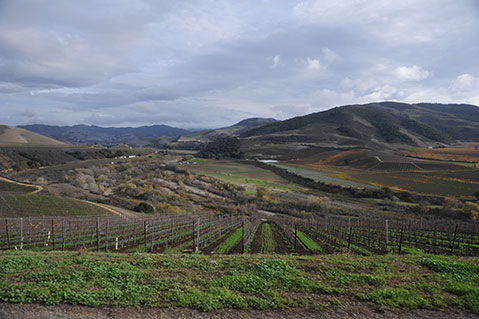
Perched high above the Santa Ynez River and dressed in faded clumps of wispy lichen, two wind-whipped white crosses enjoy what may be the prettiest view in all of Santa Barbara County. Soaring red-tailed hawks and countryside tranquility can always be found on this stretch of rolling foothills between Buellton and Lompoc, but it’s most magical in fall, when the green grass returns and autumnal shades of gold and red ripple across vineyards as far as the eye can see.
The crosses rise above the geographic heart of the grape-growing region now known to wine aficionados everywhere as the Sta. Rita Hills, today considered one of the best places to grow pinot noir and chardonnay on the planet. But it hasn’t been that way for very long. In fact, when these crosses were first erected in the early 1990s, beans and walnuts were a better farming bet than wine grapes, and most people merely snickered at the notion that any part of Santa Barbara could become a world-class wine region.
That’s no longer a laughing matter, for wine is quite possibly our wealthy county’s most lucrative industry. The seed of that reality was first planted in 1971 on land across from the crosses at Sanford & Benedict Vineyard, which provided the first evidence that quality wine was possible here.
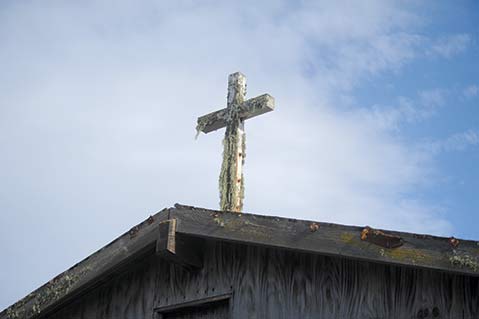
The crosses were front row observers to seeing that potential blossom: On the same property and literally in the crosses’ shadow today, the Mt. Carmel Vineyard, planted in 1990, further solidified the reputation of the region — which was federally recognized as an appellation in 2001 — and fostered wineries that are now considered iconic, such as Brewer-Clifton, whose 2012 Sta. Rita Hills pinot noir was just named eighth best wine in the world by Wine Spectator. Real estate prices have skyrocketed accordingly, with a nearby ranch down the road selling last summer for nearly $25 million.
But the crosses also bear witness to plenty of melancholy. In fact, the very structure that they rest upon — a nearly 40,000-square-foot building designed to be a monastery for about 20 cloistered nuns — is an utterly dilapidated landmark of failed dreams. Construction crews walked away from the problem-riddled project when the nuns’ money ran out more than 20 years ago, so the half-finished monastery sits in perpetual purgatory.
Inside the exposed plywood walls and perfectly intact glass windows are unattached toilet bowls and kitchen sinks, cans of paint thinner, piles of drywall, and leftover hammers. Red tiles sit in stacks on the roof, tumbleweeds grow in alcoves, and reams of wallpaper, shredded wood, chunk of cement, and other detritus are piled up out back. Yet the dead building is eerily alive — songbirds scamper in the towering chapel’s shade amid rumors of resident coyotes and cougars — and, from a short distance away, it looks like an ongoing project, as if construction crews are merely on lunch break.
The crews aren’t coming back, though, and the building will never be finished. Today, along with the 24-acre Mt. Carmel Vineyard, which is still leased by the man who first planted it, the half-finished monastery and the surrounding 201 acres (including 61 acres of new vineyard) are known as Rita’s Crown, which the state’s public employee benefit firm CalPERS owns as an investment property. Last summer, CalPERS sold the nearby Rancho Salsipuedes for nearly $25 million, so many believe Rita’s Crown, monastery and all, will hit the market sometime neat year, as the retirement fund seeks to exit the risky real estate game.
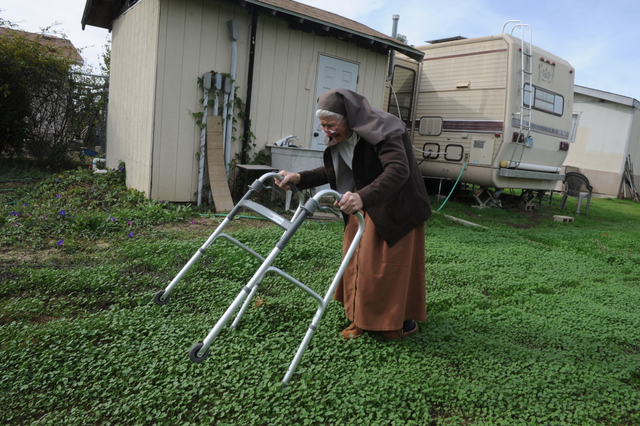
The nuns, meanwhile, never left. The Carmel of St. Joseph order lost the building, the vineyard, and about 300 acres of land in the ensuing lawsuits and bankruptcy, but Sister Jean Marie, Sister Patricia, and Sister Mary Anne, all in their eighties, still live just down the hill in a collection of manufactured homes and trailers propped up on cinder blocks. They see their failed dream on the way to 8 a.m. mass at Mission Santa Inés every day of the week — when they also drive through now-famous vineyards, such as Sea Smoke, that their former land inspired — yet rise above what must at times feel like a cruel penance.
“I’ve been at peace about it because no matter what happened, I didn’t enter this for the property,” said Sister Jean Marie last week in the mobile home they use as a living room, the monastery’s crosses staring in through the kitchen window. “I entered this for the Lord, and no one can take Him away.”

The Big Moves
By 1986, Sister Jean Marie Kirby was 40 years into a cloistered life. Born in Los Angeles and raised the middle of five Irish-Catholic kids near the corner of Olympic Boulevard and Western Avenue, she learned about God from her devout mother, who’d met her attorney father when he taught at the Catholic University of America in Washington, D.C. Mom encouraged college, but in 1946, Jean Marie joined the Carmel of St. Joseph order in Alhambra, donned a habit a year later, and, in 1949, moved with the order to a monastery in the middle of Long Beach.
Four decades later, the city grew to be one of the biggest in California, and the monastery was amid the madness of a metropolis. “We no longer had solitude,” recalled the rosy-cheeked Sister Jean Marie, who I first met earlier this year when she greeted me with a soft, lingering handshake through her car window at the property’s gate at the end of Mail Road. She was small in stature and dressed in various shades of brown, which I expected from seeing videos of The Open Book, her fire-and-brimstone-focused cable access show. Upon leaving two hours later, I was surprised to learn that it was her 86th birthday and she was off to shake the Pope’s hand in Rome a few days later.
Their mid-1980s real estate search, which included near misses in Orange County and Ojai, was aided by inheritance money that was trickling in from the estate of Sister Jean Marie’s grandfather, who left Ireland during the Famine, became a banker in Iowa, and then founded the Western Surety Company in Sioux Falls, South Dakota. Upon seeing a listed ranch nearing foreclosure with views of the Santa Ynez River, the nuns jumped at the deal, believing it was the perfect place to erect a new monastery where the order could escape modernity and return to serenity.
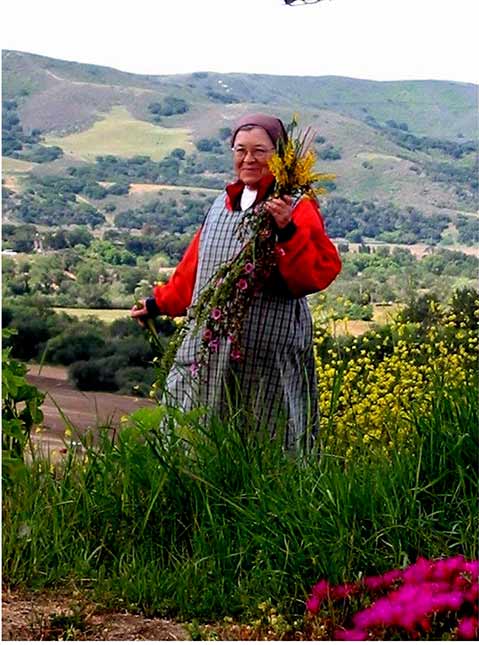
Since the nuns’ Long Beach property was such a prominent building, their move was covered by the Long Beach Press-Telegram, which is where Seal Beach fishing buddies Walter Babcock, Ron Piazza, and Paul Albrecht read that the sisters would be moving to a prime slice of Santa Barbara’s budding wine country. A dentist and restaurateur, Babcock already owned property west of Buellton on Highway 246 and was planting grapes that his son, Bryan, was turning into wine. Albrecht, a yacht salesman, was doing the same on Eleven Oaks Ranch near Solvang. Piazza, who’d worked his way up from flipping burgers to owning a bunch of McDonald’s restaurants, wanted to get in, too, so he and Albrecht would occasionally explore the Santa Rosa Road and Sweeney Canyon areas for available properties in a four-by-four. “It was impossible to find anything for sale,” Piazza told me over the phone recently.
Realizing that the nuns’ new property was a south-facing slope that overlooked Sanford & Benedict, Albrecht and Piazza — who was already a big benefactor for the Catholic Church — asked the bishop for an introduction to the nuns. Speaking to Sister Jean Marie through a protective screen, the men pitched the idea of a vineyard as a small revenue stream for the order. “Frankly, we thought this deal was, no pun intended, made in heaven,” said Piazza, who today serves on the Lakewood City Council. “It was good for them, and it was good for us.” Convinced, the nuns gave a 30-year lease on that part of their property to Piazza and Albrecht, who died in November 2013 after 80 years of life.
By the time the nuns sold the Long Beach property for $3 million and purchased the new land for about $900,000 in 1988, the deal — which included many complicated hiccups — had grown to 400 acres and involved Sister Jean Marie’s brother, Joe, who was an oral surgeon. The nuns moved to a temporary home in Solvang; most spent the days tending to various gardening and livestock duties on their new ranch, but Sister Jean Marie diligently plodded through the County of Santa Barbara’s development process, already then notorious for onerous restrictions.
For the first time since her teenage years, Sister Jean Marie was living outside of the cloistered life and navigating what quickly became a tremendously complex development project. Due to reasons that aren’t quite clear to anyone today, the order’s visions for a simple place focused on seclusion for a dozen or so nuns grew into a grand affair, as if to impress the Vatican itself.
As Sister Jean Marie’s ideas were laid down on architectural documents, Piazza and Albrecht took cuttings from Sanford & Benedict and planted them into what they called Mt. Carmel, then only the second vineyard in that specific stretch of the Santa Ynez Valley. Their dreams continue to bear fruit today, but Sister Jean Marie’s turned into a nightmare.
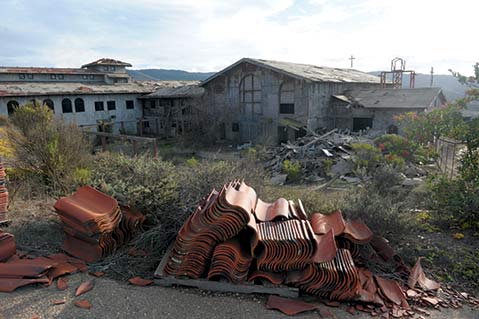
Development Disaster
The nuns were quickly welcomed into Santa Barbara wine country, even becoming celebrities of sorts by attending winemaker lunches, pouring wine at festival, and attracting support from proud Catholics and most everyone else. But when plans for a 40,000-square-foot monastery in the middle of virgin agricultural land first came to the County of Santa Barbara in the summer of 1988, decision makers were baffled.
“I was sympathetic with their intentions, but absolutely opposed,” recalled Michael Benedict, who was the 4th District planning commissioner at the time and lived until 1990 at the Sanford & Benedict Vineyard, which he’d planted with Richard Sanford. (The two men bristle at the thought of speaking together today.) Because Benedict had an easement to a well through the nuns’ property, he recused himself from voting on the matter, but he helped them weave through the planning process anyway. “They were innocent ladies who didn’t know anything about the ways of the world,” said Benedict. “They were not astute or penetrating in their business dealings.”
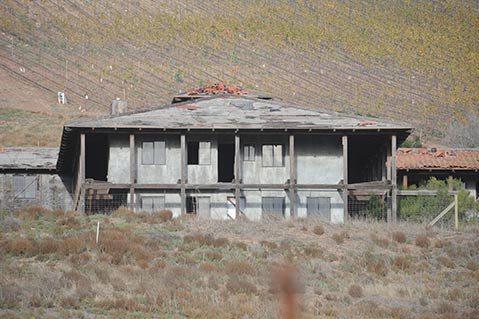
The other commissioners were also reticent to allow such a development in the middle of farmland, but constitutional protections for religious freedom superseded county concerns about view sheds, square footage, and aesthetics. Denying or requiring drastic changes could be grounds for a federal lawsuit. Plus, all decision makers were “heavily lobbied,” said Benedict, who recalls getting more than 50 phone calls from area Catholics demanding approval. “So the project got approved,” said Benedict, “and that was just the beginning of this sad saga.”
Though Sister Jean Marie wanted to move slowly, the county required construction to proceed quickly. Sister Jean Marie’s cousin was initially involved as a contractor of sorts, but the architect he hired quit upon a brain cancer diagnosis. So the nuns had plans drawn up by architect R. Brian Nelson, who’d recently finished the Santa Barbara Rescue Mission. Then they hired Santa Maria’s Diani Construction, which had just built a home for the Josephite Fathers in Orcutt.
Right away, there were problems with the plans’ structural engineering, so much so that the first engineer, Max Onichak, warned the architect and county in March 1992 that construction should cease. “If you start a job and the drawings aren’t done properly, you’re gonna run into a lot of problems,” Onichak said over the phone from his office in Hawai’i, still wondering why his advice was ignored and the construction commenced. “Then the stuff hit the fan,” said Onichak, lamenting that this was the only project in his 50-plus-year career that sits unfinished. “Everything became one big mess,” he said.
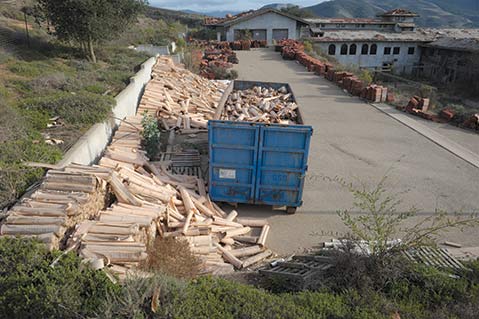
The latter comment has unanimous agreement today, but fingers point in all directions as to why. By the time the nuns’ money ran out and workers walked away in 1993, Sister Jean Marie was blaming the county for the pressure, Nelson for the plans, and the Dianis for everything else. Many who watched the situation unfold, primarily through press reports, feel that the nuns were taken advantage of, that the hired hands acted as if they were eating from an endless trough of Catholic Church money.
But there’s no hard evidence to support that, and Jim Diani and Nelson (through his wife, Marcia) outright deny the allegation. Each say that, because they were dealing with nuns, they didn’t follow their usual due diligence. Since then, the Catholic-raised Diani won’t work on a project without analyzing the finances first, and Nelson, who’s dedicated most of his professional life to building homeless shelters, won’t engage on a deal unless a general contractor is involved. Like Onichak, both admit the project is the only unfinished tarnish on their résumés.
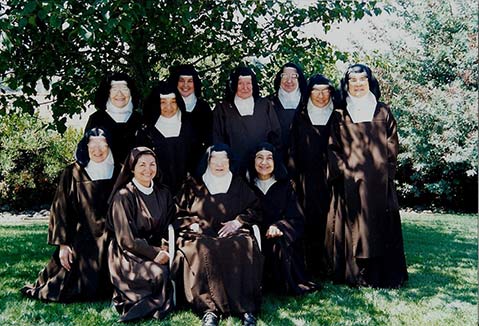
Instead, almost every one of the two dozen people interviewed for this story believe that, at the end of the day, the cloistered order of nuns simply got in way over their heads and eventually learned that faith, no matter how devotional, doesn’t write checks. “All those little nuances, the structural issues and the county permitting issues, they weren’t significant,” said Diani, whose company, which his dad founded in 1949, “took hits” in the press for what he calls “misrepresentations” when construction ceased. “They were just significantly short of funding.”
Finding out exactly how much proves difficult, but Sister Jean Marie recalls thinking that the project as proposed would cost $1.5 million. By the end, she says the order paid out more than $3 million, including donations from widely publicized fundraisers and other Carmelite orders. It wasn’t enough to finish the project, but Sister Jean Marie still believes everyone was paid in full for work done. Lawsuits nonetheless ensued, and the Dianis prevailed in theirs, though they eventually only got 20 cents to the dollar owed, according to Jim Diani.
Officially bankrupt, the nuns almost lost everything, but Sister Jean Marie’s brother Joe agreed to relinquish his interest in the 300 acres that included the monastery and vineyard in exchange for the bank backing off the 100 adjacent acres that he owned. That’s where the sisters live now, their trailers surrounded by shrines, stunning vistas, and Stations of the Cross withering from weather and time.
With the dream disastrously done, the Carmelite superiors told the remaining nuns to adhere to their vows and return to cloisters in proper monasteries. Sister Jean Marie and Sister Patricia defied the order and stayed; Sister Mary Anne returned after a short stint away. [CLARIFICATION: After this article was published, Sister Jean Marie explained that the order did grant the nuns “exclaustration,” which is the ability to continue their work outside of the cloister, so they did not break their vows of obedience.] They still consider themselves Carmelites but are known as Divine Mercy now, which is the name of the corporation that holds their property in trust. With “visions” a recurring theme in her daily discourse, Sister Jean Marie — who believes the world is “rushing to its ruin” but says she knows that will be followed by a great return to God — remains a central, almost prophetic figure in the eyes of her fellow sisters, and any regrets are consoled by unflappable faith.
“It’s been up and down, with a lot of joy, a lot of heartache, a lot of tears,” said Sister Patricia in her brown habit last week as gray skies swarmed above their private trailer park. “But the Lord is with us, and we are with Him. We have made the right choices all along.”
Most others see it differently. “Given the naïveté, the simplicity of the nuns, their open-heartedness, and their willingness to help others, it was a travesty how things unfolded,” said Benedict, who believes they were taken advantage of along the way but admitted that the nuns and their “moral advantage” were “coconspirators” in that demise. “It left this scar that’s been sitting here in the middle of the Sta. Rita Hills for years and years.”

Wines That Rock
Around 1997, Greg Brewer, who’d left a safe career teaching French literature at UCSB, was making $7 an hour at Santa Barbara Winery, so he had to save up to buy a $25 bottle of chardonnay that Bryan Babcock made from Mt. Carmel Vineyard. Because his dad was best buds with Piazza and Albrecht, Babcock made the first Mt. Carmel wines, and the results were immediately impressive. Brewer met up with his friend Steve Clifton at Clifton’s apartment on Chapala Street to drink the bottle, and the two — who’d just started their own Brewer-Clifton Winery the year before — were stunned. “That wine changed our lives,” said Brewer, and the two began vying for a chance to buy grapes from the vineyard, which was also coveted by pioneers like Rick Longoria and Au Bon Climat’s Jim Clendenen.
Then came the surprise call for a last-minute, late-afternoon pick before a rainstorm during the 2000 harvest. Clifton got the trailer stuck in the river, but Brewer had no idea what was taking so long as he watched the ominous clouds assemble above the perfectly plump grapes. “It was really dramatic and exciting and awesome,” said Brewer, and the two managed to get the fruit to the winery, where rain started falling as they finished pressing the grapes. “To this day, that’s one of my favorite wines I’ve ever made,” he said.
That’s despite the fact that Brewer, Babcock, and Longoria — who gathered in my kitchen a few weeks ago to taste through about 20 different Mt. Carmel wines — remember that the vineyard wasn’t in good shape back then. “It was always one step behind,” said Babcock. The vineyard succeeds against all odds because the chalky, white limestone soils make it hard for vines to survive, so they focus their energy into the few grape clusters. That translates to intriguing flavors in a finished wine, which are further enhanced by the long ripening season that the south-facing hillside enjoys due to constant wind and frequent fog. Those characteristics are also associated with the wider region around Mt. Carmel, and vintners convinced the federal government that the area between Buellton and Lompoc should be a separate wine-grape-growing appellation called the Sta. Rita Hills, which was approved in 2001.
For Babcock, Mt. Carmel also provided a career-changing “wakeup call.” Many years ago, he poured both the Mt. Carmel and his “Grand Cuvee” — of which he was most proud, as it came from his family’s grapes — for an important wine buyer, who promptly declared, “You know, the Mt. Carmel is better.” That opened Babcock’s mind to appreciate other vineyards as much as his own. “It’s made me more aggressive today in going after so many of these vineyards,” said Babcock, who today makes widely acclaimed wines from both his family’s estate as well as an array of vineyards throughout the Sta. Rita Hills, including Rita’s Crown, adjacent to Mt. Carmel. “I fully accept the fact that my vineyard may not be the best, and that there are these stunning vineyards that are off the charts. I’m okay with it.”
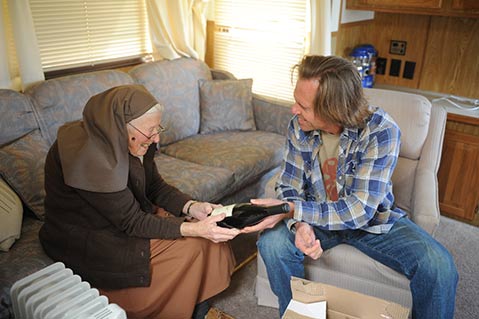
The farming got better in 2005, when Brewer and Clifton convinced Piazza and Albrecht that the two winemakers should farm the vineyard and use the grapes exclusively. What about Babcock, Longoria, Clendenen, and others who’d bought grapes for years? “I don’t imagine they were stoked,” admitted Brewer, though he’s quite friendly with all of them to this day. That tenure, which lasted until frost decimated the 2011 vintage and the vineyard contract “fizzled,” turned Brewer and Clifton into farmers, thereby improving their winemaking, as well. Though they no longer use Mt. Carmel fruit, they do farm three other vineyards around the Sta. Rita Hills today in very much the same program they started around the tattered monastery.
In 2012, for the first time ever, Piazza started taking the grapes for his own project. “I’ve put so much money into the vineyard, I’ve become convinced that the only way to return a little investment is to sell some wine,” said Piazza, who joked that he has to own 10 McDonald’s now to pay for the vineyard. “So we are making a go of it with Mail Road Wines to see if we can at least break even.”
A partnership with McConnell’s Ice Cream owner and longtime wine lover Michael Palmer, Mail Road Wines are made by Matt Dees, a young but highly celebrated winemaker. Before he agreed to take on the project, Dees called Brewer to make sure he was cool with it, and he was. The initial release, which goes on sale early next year, received extremely high praise from influential critics, one of which called it the most promising first release of any winery in Santa Barbara history.
“There’s an incredible directness to the Mt. Carmel wines,” said Dees, who also attended the kitchen-table tasting with Palmer to show off the new project. “They’re shockingly straightforward. They start off like a laser beam, and the evolution in just one year in the barrel is like something I’ve never seen.”
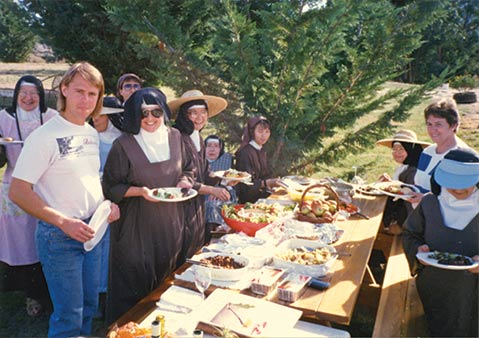
Owning the Crown
Though Ron Piazza will extend his lease on the 24-acre Mt. Carmel Vineyard for another quarter century when his first 30-year lease comes up in 2017, he admits that not buying the entire property when it went to auction out of the nuns’ bankruptcy was a big mistake. Instead, a developer named Joe Risi, who started building a fortune on Las Vegas and Arizona real estate at age 19, bought the 300 acres on Halloween of 2001 for $1,040,000. He didn’t know much about wine or even the empty monastery, but it was the aftermath of 9/11, and he figured it would be a beautiful place to hole up if the world went to war. “It really did feel like Armageddon, and we were all kinda freaked out about the state of the world,” Risi said over the phone from Tuscon. “My feeling was that if we were all gonna be wiped out and die, I’m okay dying on that property.”
Right around the time that he toured the property for the first time with Sister Jean Marie and learned of her visions that the monastery would yet be completed, Risi experienced health scares that, according to even his doctors, completely disappeared in a miraculous fashion. The tremendous series of events, which Risi later shared in front of an audience of 20,000 people as well as on an inspirational DVD, is too detailed to dwell on here, but it changed his life. He became a devout Catholic, volunteered in a Rwandan village, and had bronze statues of the Madonna made for Our Lady of Mt. Carmel in Montecito as well as a handful of holy sites around the world.
Risi tried in vain to get the Catholic Church and others to buy the property and fund completion of the monastery, and eventually entertained the interests of Keenan Ivory Wayans and a helicoptered-in group of black-suited gangsters. He sold off the 100-acre parcel for about $1 million, which is now Wenzlau Vineyard, and at one point was in escrow to sell the rest to Stan Kroenke, the mogul who owns Jonata Winery (which is located in Santa Barbara County’s Ballard Canyon) as well as the Denver Nuggets and other teams. Kroenke instead bought the cult Napa winery Screaming Eagle, but did come through on his Sta. Rita Hills dreams last summer by buying the nearby 3,600-acre Rancho Salsipuedes and its 200 acres of vines spread across the Radian, Bentrock, and Puerta del Mar vineyards from CalPERS, which invests in vineyards all over the West Coast. That deal was reportedly for $24,142,000, according to the County of Santa Barbara’s assessor.
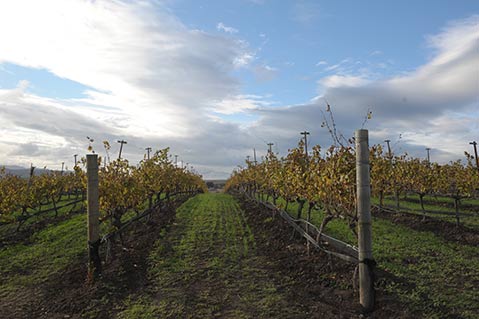
In 2007, Risi was approached by Napa vintner William Hill, who fronted one of CalPERS’s investment wings called Santa Colina LLC (which means “holy hill”) that then bought the property for $4.5 million. Right away, Hill planted 61 acres of pinot noir and chardonnay as Rita’s Crown Vineyard, and respected vintners such as Ken Brown and Bryan Babcock have been using the fruit ever since.
It’s not easy to tell that CalPERS still owns the property — the shell game of ownership entities serves to distance the retirement fund from bad publicity over risky real estate investments — and many believe that the property will hit the market next year. In fact, a visit to the website of Pacific Vineyard Partners & Meriwether Farms, the current ownership front, reads as if the property is already on the market. Given that the sale includes a 40,000-square-foot nuisance that will require at least $500,000 just to tear down and a long-term lease on the property’s premier vineyard site, it may be a tougher sell than usual.
And no one’s taking Mt. Carmel from Ron Piazza, who’s fended off previous attempts to kick him off the lease from every owner. “I’ve been challenged by the nuns, by Risi, and by a couple of others,” said Piazza. “We’ve stood the test of time in court, so I feel pretty comfortable that I’m there for awhile.”
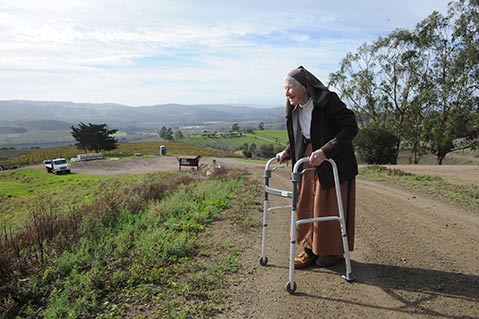
Faith in the Future
Last month, Sister Jean Marie underwent an aortic valve replacement in anticipation of hip surgery next spring. Yet she was happy to romp with her walker through the sprouting clover when I visited her last week, and she smiled upon Bryan Babcock, whom she hadn’t seen in years. He profusely thanked the nuns for the impact they’d made on Santa Barbara wine country and his own career and gave Sister Jean Marie a case of his Slice of Heaven pinot noir, which is from Rita’s Crown and is an ode to the nuns.
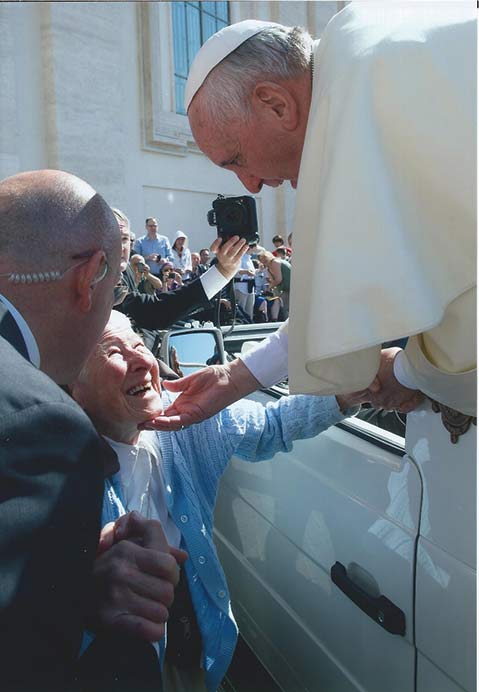
“The nuns were looking for their little slice of heaven, and they were in the right place, but they missed just slightly,” Babcock said. “Outside the walls is perhaps one of the first grand crus ever to take place in Santa Barbara, but inside of the walls is the deepest, darkest funk.”
There’s an expected amount of bitterness in Sister Jean Marie, who follows her knowledgeable explanation of why wine grapes excel in the Sta. Rita Hills with the lament that the sisters never benefited from the discovery. There’s also quite a bit of mysticism and intrigue woven into Sister Jean Marie’s version of events, from the dreams of neighbors to alleged attempts on their lives to wildfires that stopped just short of the monastery’s wooden walls. But most of all, Sister Jean Marie believes that the monastery will one day be completed as planned.
“The monastery will yet be finished,” she told me at the end of our first meeting back in May. “A great work lies in the future, and that’s comforting to my soul.”
Wines from Mt. Carmel Vineyard
Highlights from November 25, 2014 Tasting
Babcock 1997 Pinot Noir: “That is amazing,” said Rick Longoria of the still bright and savory flavors of truffle, soy, and mushroom. Looking at the label, which features a drawing of the monastery, Bryan Babcock quipped, “That’s the best the convent ever looked!”
Longoria 2001 Chardonnay: Nutty with a lemon-peel tension. Said Matt Dees while tasting the wine, “The vineyard can get ripe as all hell, but the acidity is shockingly high.”
Au Bon Climat 2002 Chardonnay: Hints of green olive. “This smells like Mt. Carmel to me, a weird alkaline thing,” said Michael Palmer.
Brewer-Clifton 2008 Chardonnay: “This is one of the top five or six things in my life that I’m proud of,” said Greg Brewer, who believes the vineyard impacts a dairy characteristic, like a rind of brie cheese.
Brewer-Clifton 2010 Pinot Noir: This was the winery’s first 100 percent whole cluster bottling, meaning that the stems are fermented with the grapes, giving more savory elements. “That’s really well integrated,” said Longoria.
Mail Road 2012 Chardonnay: Green apple and lots of fresh fruit, which Brewer called “a departure” from his style, though he liked it. “It still has that dairy quality,” said Longoria. Dees said the vineyard now struggles immensely to get the fruit ripe, which is a good thing. Said Dees, “I like the direction that it’s going.”



